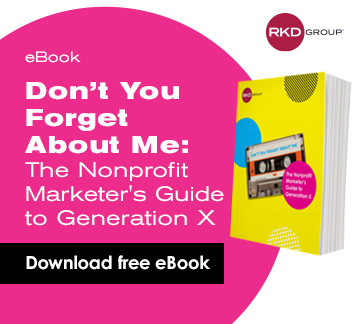The sudden cancellation of federal funding for food distribution programs has caused a ripple effect for food banks across the United States. Some organizations have lost a lot of direct financial support from the government, while others anticipate the funding cuts affecting them sooner or later.
Many food banks need the additional support of their donors to help bridge this funding gap. In this blog post, we’ve rounded up some examples that may help guide your messaging and efforts in these unpredictable circumstances.
As you’ll see below, food banks are navigating the complex landscape of funding cuts with a blend of advocacy, urgency-driven fundraising and message moderation, all tailored to their unique donors and communities.
Continue reading for things to consider when tailoring your messaging, deciding on your tactics and facing other external factors. With these resources, we hope you feel empowered to decide how and when to respond.
Guidelines for tailoring your messaging
Let’s dig into what you may or may not want to say to your donors.
Stick to your mission
Politics nowadays are a hot-button issue. Although you may feel called to speak politically to your donors, staying focused on your mission to end hunger may resonate more with your supporters. Feeding people is what is at risk, so it’s important to reiterate your dedication to your community.
Time strategically
When you send a message is just as important as what you say. So, when should you push out your messaging? Save your urgent messages for when you really need them—when the impact of funding cuts becomes more visible or when donors don’t feel so fatigued.
You can also pair these efforts with larger appeals like summer campaigns and day-of-giving campaigns.
However, don’t wait to craft your messaging. The news changes every day, so you must be ready with your emergency plan set to launch. Don’t miss the opportunity to better connect with your supporters and neighbors.
Cite third-party sources
To help mitigate potential backlash, food banks can reference local news articles in their messaging for increased credibility and reduced bias.
One of our clients, North Texas Food bank, deployed a broadcast text message that included an article written by a local newspaper. The message, tailored to drive urgency and authenticity, helped raise funds and continued the food bank’s story of being an asset to its community. 
Utilize dual-purpose messaging
Your efforts can do two things in one: advocacy and fundraising.
Food Bank For New York City drafted two emails to engage donors and raise awareness around the larger policy changes. They included a mix of donation and advocacy asks.
Our team helped create the graphics and build and send the emails. This small campaign raised over $12,000, proving a tailored message will resonate with donors.


Tactics for your message
Once you decide what to say, you can use the following tools to share your story:
Peer-to-peer texting
Peer-to-peer (P2P) texting is best suited for fast and personal messaging to quickly mobilize support.
Food Share of Ventura County sent out a P2P text that raised over $12,000 from 141 gifts in one day! They saw a 6:1 ROI. This was a huge win for a smaller food bank.

Here’s another example: Houston Food Bank operates one of the largest food banks in the country. From the cuts, they are losing about 500 truckloads of food per month. They made the decision to push out a message asking their community to give. Their total campaign raised over $15,000 from 185 gifts, with their text message raising $11,000 in the first hour and $4,000 over a weekend.

Although they are a larger organization, smaller teams can still garner lots of support from their donors. And remember that it isn’t just about donations―but awareness. Each interaction with your donors strengthens your story and presence.
Although less individualized than P2P texting, broadcast texting is another option that provides a modest but efficient tool for one-off engagements.
Email campaigns
Emails are a great option for multiple asks like advocacy and donations. They’re direct and allow for resends.
Second Harvest Food Bank of Central Florida created and sent their own emails and resends. They featured a straightforward ask for donations. These have raised roughly $33,000, a great success. They also created a monthly donor version of the ask. Their sustainers, Meal Makers, gave more than half the raised amount.

Newsletter
If you are looking to focus on advocacy or partnership, a newsletter would be an ideal venue. You can include letters from your executive, share important messages and unite community members behind a common goal.
The Jacobs & Cushman San Diego Food Bank added a note from their CEO in a newsletter they wrote and sent to their nonprofit partners. They wanted to make sure their partners knew they could continue to rely on them for the food needed for their programs. This newsletter focused on partnership rather than fundraising, although the food bank has received donations from supporters. They sent fundraising appeals to donors via email, social and mail and used those touchpoints as opportunities for meaningful conversations.

Other factors to consider
Before you share your messages and asks with your community, consider a few factors that may impact their response or your capabilities:
Level of impact dictates action
A food bank’s size may determine how impacted it's been by the federal funding cuts. Larger organizations tend to be more affected and, thus, more motivated to fundraise. Other teams who have not yet seen great losses may hold off or approach messaging and asks with caution.
Internal capacity affects agility
Ensure your internal team can be flexible and responsive. If you’re working through team member changes or responding to emergencies or more pressing campaigns, you can prioritize those projects before pushing out cuts-related messages.
Leadership buy-in matters
Food banks may be waiting on CEO approval or considering board members’ comfort levels before launching a complex fundraising effort like this. A united front and thorough communication are important for comprehensive messaging and community response.
While no two food banks face the exact same challenges, one thing is clear: The need is growing, and the support structures are shifting. Whether you’re already feeling the sting of funding cuts or bracing for what’s ahead, your response doesn’t have to be reactive—it can be strategic, intentional and deeply rooted in your mission.
With uncertainty around future federal funding, the best course of action may be to prepare an emergency communication plan. Your agency partner can help you create a strategy and tailor tactics.
By carefully considering your message, timing your outreach and selecting the right tactics, you can meet this moment with confidence. Remember, the goal isn’t just to raise funds—it’s to deepen trust, build resilience and continue feeding your community.





Leave a comment: